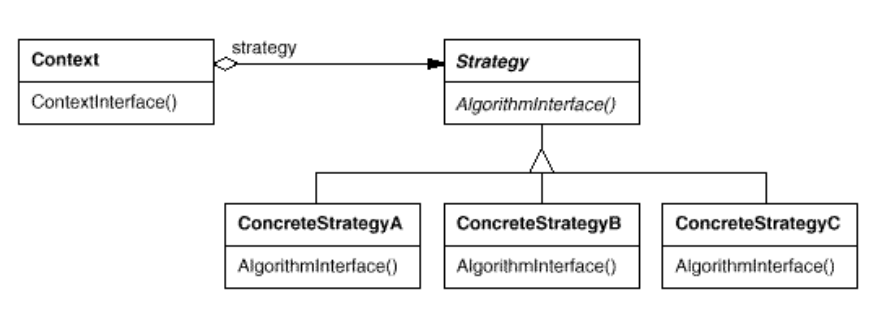21. Strategy
- Intent:
- Define a family of algorithms, encapsulate each one, and make them interchangeable. Strategy lets the algorithm vary independently from clients that use it.
- Also Known As:
- Policy
- Applicability:
- many related classes differ only in their behavior.
- you need different variants of an algorithm.
- an algorithm uses data that clients shouldn’t know about.
- a class defines many behaviors, and these appear as multipleconditional statements in its operations.
- Structure:

- Participants:
- Strategy
- declares an interface common to all supported algorithms. Context uses this interface to call the algorithm defined by a ConcreteStrategy.
- ConcreteStrategy
- implements the algorithm using the Strategy interface.
- Context
- is configured with a ConcreteStrategy object.
- maintains a reference to a Strategy object.
- may define an interface that lets Strategy access its data.
- Strategy
- Collaborations
- Strategy and Context interact to implement the chosen algorithm.
- A context forwards requests from its clients to its strategy.
- Consequences:
- 1.Families of related algorithms.
- 2.An alternative to subclassing.
- 3.Strategies eliminate conditional statements.
- 4.A choice of implementations.
- 5.Clients must be aware of different Strategies.
- 6.Communication overhead between Strategy and Context.
- 7.Increased number of objects.
- Related Patterns:
- Flyweight: Strategy objects often make good flyweights.
- Code Sample: Strategy

public interface ICalculator {
public int calculate(String exp);
}
public abstract class AbstractCalculator {
public int[] split(String exp,String opt){
String array[] = exp.split(opt);
int arrayInt[] = new int[2];
arrayInt[0] = Integer.parseInt(array[0]);
arrayInt[1] = Integer.parseInt(array[1]);
return arrayInt;
}
}
public class Plus extends AbstractCalculator implements ICalculator {
@Override
public int calculate(String exp) {
int arrayInt[] = split(exp,"\\+");
return arrayInt[0]+arrayInt[1];
}
}
public class Minus extends AbstractCalculator implements ICalculator {
@Override
public int calculate(String exp) {
int arrayInt[] = split(exp,"-");
return arrayInt[0]-arrayInt[1];
}
}
public class Multiply extends AbstractCalculator implements ICalculator {
@Override
public int calculate(String exp) {
int arrayInt[] = split(exp,"\\*");
return arrayInt[0]*arrayInt[1];
}
}
public class StrategyTest {
public static void main(String[] args) {
String exp = "2+8";
ICalculator cal = new Plus();
int result = cal.calculate(exp);
System.out.println(result);
}
}
